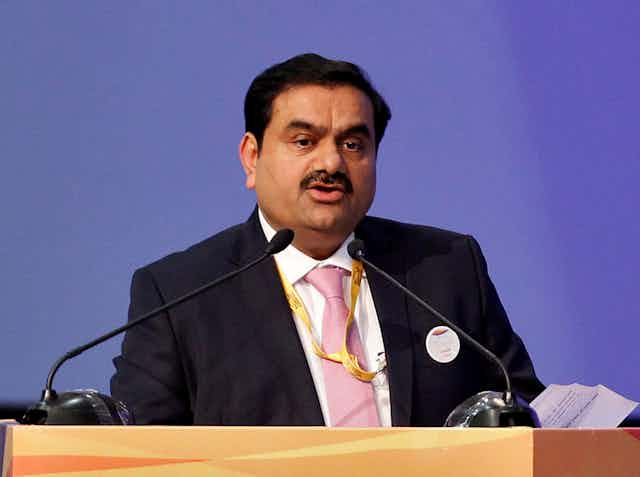Indian multinational Adani Group is becoming a more familiar name in Australia, as the company’s interest in its proposed Carmichael coal mine in Queensland grows. At the same time, there’s concerns the arrangement may shift some of its likely revenue, even if it does deliver on all of the promised business and job opportunities for Australia.
Profit shifting has been tied to the labyrinth of financial structures and ownership, related to different companies within the publicly listed Adani Group and/or family members. Even though this setup draws scrutiny in developed countries like Australia, it’s common and makes sense in the context of emerging markets like India.
Since 2013, Adani’s growing interest in the Carmichael mine has been tied to volatility of global coal prices and sea-borne freight rates. However the financial viability of the project has remained questionable. Most Indian companies’ overseas interests and large investments, barring that of Tata Motor’s acquisition of Jaguar Land Rover, during the 2008 crisis, have not yet been financially rewarding.
Why Adani is structured the way it is
Family-run diversified conglomerates are the norms of many developing nations. In India, older family-run business conglomerates like Tata and Birla have lately seen others joining the club – from Mukesh Ambani (and his brother’s ADAG part) to Adanis, to Mahindras. In Japan, such structures are known as Keiretsu and in South Korea, as Chaebol.
While this might seem like organised chaos in the context of developed countries, studies have shown that centralised and focused, core competency driven strategies in businesses may not be the best choice in emerging markets like India. This is because of uncertainty around government policy and the need to “manage” government expectations.
Many emerging countries like India have seen a rise in industrial billionaires from businesses that rely on government policies that allocate natural resources. The rise of the Adani’s private individual or publicly-listed companies in the group are historically linked with coal trade - starting with when it was private back in the 1980s.
Doing business in developing nations or with companies in developing nations has never been easy. Some businesses like, Adani Group, have mastered that art well by creating a series of connections with the government.
The key man behind all of Adani’s business interests and fortunes is Gautam Adani. Many view the rise of the group as interwined with the rise of the political career of India’s Prime Minister, Narendra Modi, starting with the days when he was the Chief Minister of Gujarat.
In businesses controlled and founded by a family there’s usually a haze of subsidiary companies, with opaque corporate governance and structures. However there are exceptions in some of these diversified groups, like the Mahindras, who exhibit exemplary corporate governance and transparency.
Conservative accounting norms suggest businesses should factor in the worst possibilities, both in terms of liabilities as well as assets. But the discretion on what exactly is reported has always remained opaque.
Accounting standards allow listed companies to merely disclose, without recognising, contingent liabilities. These standards also don’t require disclosure nor recognition of contingent assets, where potential economic benefit is dependent solely on future events that can’t be controlled by the company. This can lead to accounting and legal complexities.
More importantly, there is a need for transparency on what all business interests top management may have, whether those business interests are privately held (and onshore or offshore), or listed. Business leaders should also report any potential conflicts arising from the same person representing multiple boards, or taking key decisions in different companies.

The success of the group
The rise of the Adani group over the last three decades has been phenomenal. It now has keen interests and operations in three equally vital components, namely resources, logistics and energy.
Indian media have scrutinised Adani Group from obvious and visible allegations of cronyism, to accounting malpractices related to under-invoicing or over-invoicing.
The group also remains one of the most leveraged groups in India, meaning it borrows a lot of capital for investment, expecting the profits made to be greater than the interest payable. This is at a time when India’s state-owned banks have been suffering from chronic non-performing loans or assets, usually funded by the government, with taxpayers’ money.
Adani’s key listed companies are Adani Power, Adani Ports and Adani Enterprises (other one being Adani Transmissions Ltd).
Adani Enterprises, the arm of the group involved with Carmichael coal project, had a demerger back in 2015 from a more complex holding structure. The demerger created shareholder value in the other listed group companies, because of a loss of the risk of uncertainties related to the big Carmichael mine’s liabilities. Naturally, Adani Enterprises’ stock tanked 80% with that demerger.
Adani Power’s problems are twofold – the unavailability of domestic fuel and local demand for power in the power-surplus Gujarat state of India. This means the company’s plants are underutilised, leading to low financial performances.
Even though Indian business houses might have similar structures, they don’t all act the same. Some have matured after burning their fingers; and follow best accounting and corporate governance practices.
Adani group is comparatively a new kid in the block. So the question remains on whether the Adanis would help improve perceptions of Indian business and investment overseas in the years to come. Developments so far in the Carmichael mine do not indicate an easy ride.

